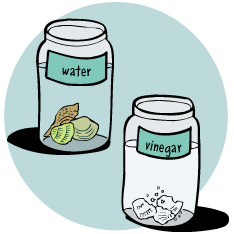
Shell Shocked
[30 Minutes]
Some scientists believe that acid rain, water pollution, and global warming have been contributing factors in the bleaching of coral reefs. Bleaching or the discoloration and loss of symbiotic zooxanthellae have been discovered in the coral reefs off Okinawa, Easter Island, and the Caribbean Sea. Without symbiotic zooxanthellae the coral reefs cannot deposit calcium carbonate and the reef organisms lose their habitat. It takes years for reefs to recover. Experiment with shells and vinegar to observe the powerful effect of acid rain and water pollution.
You'll need:
• small seashells • metal spoon • newspaper • 1/2 cup water • 2 small jars • 1/2 cup white vinegar, (Read warning on packaging) • masking tape • marker
What to do:
- If possible, print out these directions. Read them through with your child before you begin.
- Gather everything you'll need and always remember science safety.
- Place a few seashells in one jar and add 1/2 cup vinegar.
- Label the jar.
- Place a few seashells in the second jar and add 1/2 cup water. Label the jar.
- Leave the shells in the jars for four days.
- Cover a workspace with newspaper. Remove the shells from the jars and place them on the newspaper.
- Use a metal spoon to try to break the shells apart. Observe what happens.
Useful information:
The acid in the vinegar acts much like acid rain. The acid has the power to break down the calcium carbonate element of the shells, eventually destroying them. In some areas of the world, acid rain works just like the vinegar.
|